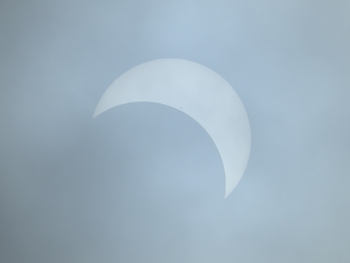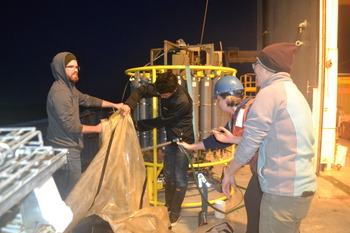Luckily, the monotonous deployment and recovery of 2900 meters of cable was punctuated by the emergence of two sharks.
Aug 24, 2017
Unsure whether today began early or started late. Had my 00:00 to 04:00 shift in the Jason control van again, after which I assisted Katie and Orest sampling the Niskin bottles attached to Jason. (Those bottles collect water samples while at depth so the in situ geochemistry can be analyzed.) A great experience and fun to get some more hands-on work with water samples. This did, however, result in a bedtime at 06:30. Followed by getting up at 12:30. So, early or late? I’ll let the peanut gallery decide.
The Jason shift was a bit easier to follow this time around. Luckily, the monotonous deployment and recovery of 2900 meters of cable was punctuated by the emergence of two sharks. Us, a varied mix of engineers, physicists, and chemists did our best to identify the Chondrichthian creature. With between 0 and 100% confidence, we called it a Blue Shark (Prionace glauca).
After grabbing some sleep, the undergrads and I assisted our resident post-doc, Wu-Jung. Wu-Jung is hoping to squeeze a plankton tow into the schedule sometime tomorrow, so we needed to prep her net today. So many carabiners. (They hook onto the frame and, given large force of water rushing through the net, the tension needs to be displaces as widely as possible around the frame.) Looking forward to deploying it tomorrow!
The rest of the day was spent relaxing as we skipped through the water to our next site. Currently prepping for a late 01:30 launch of Jason. To sleep or not to sleep before hand?
…
(01:00) To not sleep. Apparently. How time flies while writing research proposals.
(04:15) Jason shift went well. 2 more sharks. 1 ROV. 0 regrets. I’m finding the shifts in the Jason control van to be an excellent time to sit back and think about the research going on out here on the Juan de Fuca plate. Everything the bathymetry to microbiology. Having spent the earlier part of the night working on a research proposal for the first part of my dissertation work, my thoughts have migrated to ways in which I could dovetail the goals of my work to those of the Cabled Array and OOI in general. The lab I’m in at UW (Gorman-Lewis) focuses on quantifying the thermodynamics of microbial growth. I know that the microbial mats along the methane seeps and hydrothermal vents here have been studied to a fair degree, but to my knowledge there haven’t been any attempts at culturing them in the lab and to try and quantify consumption of Gibbs Free Energy. The ever-present problem with such studies, of course, is replicating in situ conditions in the lab – which is only exacerbated by the depth (i.e., pressure) at which those mats grow. Also getting the correct geochemistry in a lab-made aqueous media would be a challenge. Perhaps an initial study examining one of the taxa present in those mats (obtained through a company such as American Type Culture Collection) would be a more practical first step. Much to think about. Perhaps some sleep will aid in that…
Au revoir for now.
Aug 22, 2017
Today began late. It seems my body is even more resistant to the calls of an alarm clock while under the influence of meclizine hydrochloride.
The R/V Revelle is reminding me more and more of the other Scripps ships I’ve been fortunate enough to sail on – the Point Sur and New Horizon. Wonderful food, engaging and humorous crew members – even down to the layout of the snack bins in the galley. This has brought back fond memories of working with the Bishop lab at UC Berkeley in my undergrad days, where we deployed water-sampling robots and were trained how to operate the CTD Rosette system.
As I write this at 14:45, the highlight of the day has been a tour of the engine room. As we squeezed our way around the engines and associated equipment, deafened by industrial-grade earplugs, I was thoroughly impressed by the extent of engineering happening just below the more camera-ready Jason.
Now just before dinner (16:30). This afternoon was defined by connecting a mooring and placing the associated RSN deep profiler vehicle into the water column. The efficiency of the crew on those deployments was admirable. I’m excited to see the data for that profiler once it’s online!
I return to you this evening (21:00) to report my first foray into collecting samples from one of the RAS filter systems. 48 filters. 2 teams of 3. Go! All went smoothly despite a constant wind threatening to discard the filter from its precarious perch between the twines of the tweezers. Couldn’t help but wonder how tedious it must have been to put that sampler together – 48 individual plastic tubes with a roughly .5 cm diameter must make for some annoying tangles. Ah, the joys of engineering!
The rest of the evening looks calm, with a Jason launch scheduled for sometime before 00:00. Just in time for my shift! Enjoyed it last night (well, technically this morning…) so looking forward to it. Hopefully this time around I’ll have a better handle on the acronyms! (Do you know your FSHPH’s from your FRHPH’s? There will be a test.)
Aug 21, 2017
First full day aboard after a long 24-hour steam out to Axial Seamount. Things started out science-related, which is always good, with the solar eclipse. Things then quickly became meteorologically related. This can be good when one is in the mood for a nice walk in the rain. This is, however, not good for when one is trying to view an eclipse of the sun. Clouds. And fog. And clouds. But then...
Darkness.
To miss seeing the sun laden with the moon's shadow was disappointing, but to experience the collective wonderment of a nearly completely darkened sky at 10 am was meaningful.
I've heard some attribute the correlation of fog build up and the eclipse to a drop in the dew point from the corresponding drop in temperature. This may explain why, shortly after totality, the fog partially lifted and we were granted bursts of solar viewing. Cheers to Orest for providing lenses! In a frantic attempt to document the moment, I took a few pictures.
The rest of the day was encompassed by discussions about the research focus of the science party members, thinking through my own research plans, and watching Jason take its first dive of this leg.
That dive was to realign a camera, and so was relatively quick. Not quite as quick was the second dive of the day -- with an estimated dive time of 12 hours. As I write this at 5 am on the 22nd it is still very much underway. Why write a blog post for August 21st at 5 am on the 22nd? Because I have the 00:00-04:00 shift in the Jason control van. Today my task was to log the on-goings of the dive, as the aptly dubbed "logger".
I’m left thinking there's something peaceful about watching a mechanical marvel perform such monumentally important and interesting work at the depths of a calm, quiet, dark ocean.
For now it is time to log off and see whether waking up for lunch is at all appealing in... 6 hours. Maybe a late lunch of leftovers.
Cheers for now.




